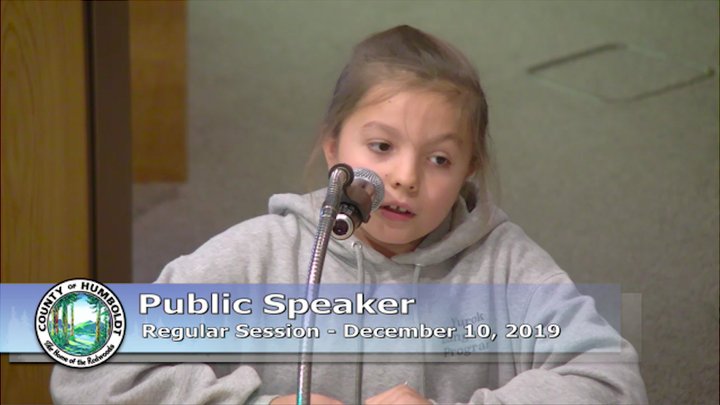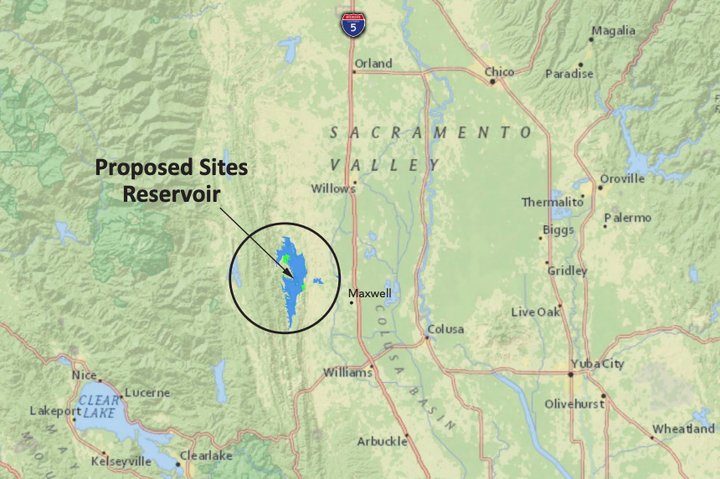
A young member of the Yurok Tribe addresses the Humboldt County Board of Supervisors.
Humboldt County officials are rethinking their support for a massive new reservoir being developed in the Central Valley after learning that the project could negatively impact the Trinity River.
The project in question is called Sites Reservoir, a proposed $5.1 billion water storage facility that’s been in the works for more than 20 years. The massive reservoir, capable of holding 1.8 million acre feet of water, would be located in Glenn and Colusa counties, northeast of Clear Lake along the I-5 corridor.

Detail of a Sites Reservoir Project map. | Image courtesy County of Humboldt.
Last year the county asked for and received assurances that this project won’t cause any additional diversions of Trinity River water to the Sacramento Basin. We say “additional” because much of the Trinity’s flow already gets diverted via the Central Valley Project, which sends water from Trinity Lake into the Sacramento River.
In January of 2018, the chair of the Sites Project Authority (the government agency that would own and operate the reservoir), responded to the county’s concerns with a letter to the Humboldt County Board of Supervisors promising that no Trinity River water would be diverted as a result of the project.
However, a technical report conducted on behalf of the Pacific Coast Federation of Fishermen’s Association and Save California Salmon suggested otherwise. It identified potentially significant impacts to the Trinity.
And so today, the Board of Supervisors voted unanimously to send a pair of letters requesting further environmental review and renewed promises from both the Sites Project Authority and the U.S. Bureau of Reclamation.
A draft letter to Sites Project Authority Chairman Fritz Durst notes that modeling published in the project’s draft environmental documents show the project “would likely cause irreversible harm to migrating salmon” in the Trinity. The letter asks that some binding language be added to the project’s water rights application. Here’s that proposed language:
Trinity River water shall not be used to fill Sites Reservoir unless the Trinity River Division of the Central Valley Project is releasing water as a result of storage conditions requiring “Safety of Dams” releases beyond normal operating plans and concurrently when Shasta Reservoir is making flood control releases. Furthermore, Humboldt County’s 1959 water contract with the Bureau of Reclamation, Trinity River Record of Decision (ROD) flows, and releases to implement the Bureau of Reclamation’s Long-Term Plan to Project Adult Salmon in the Lower Klamath River shall not be reduced or negatively impacted in any way as a result of any Sites Reservoir decisions, modeling, operational plans, and water rights petitions.
If the Sites Project Authority can’t agree to the county’s terms, the letter states, “we will consider whether to withdraw our conditional support for the proposed Sites Reservoir Project.”
The second letter approved at today’s meeting will be sent to both Durst and the regional director of the Bureau of Reclamation. It asks that the Draft Environmental Impact Statement/Environmental Impact Report be “revised and recirculated prior to certification due to significant new information regarding the expected adverse environmental effects of the project’s proposed operations.”
The letter notes that significant impacts to the Trinity River “would cause irreversible harm to Humboldt County’s commercial, sport, and tribal fisheries.”
The people who got up and spoke publicly on this issue echoed those sentiments.
“The Trinity River has zero extra water,” said Weitchpec resident Isaac Kinney.
Daniel Cordalis, a member of the Yurok Tribe, said, “Every drop of water that comes out of the Trinity now is an extreme fight,” and he voiced support for the two letters.
Margot Robbins said she’d traveled to the meeting with five students from Hoopa High School. “Our future is tied to the river, and our river is so sad,” she said. “When our animals drink it in the summer, they die.” With any more diversions the Trinity would be unable to support fish, she said, and she argued that the project’s environmental assessment should be redone.
Denver Nelson, a retired neurosurgeon, longtime river advocate and former member of the Humboldt County Planning Commission, was the lone voice of support for the Sites Project. He called it “a good thing to happen” and said it has “no connection to the Trinity River.”
Nonetheless, the board was united in its decision to send the two letters. “It’s about time,” said Fifth District Supervisor Steve Madrone.
“I totally support this as well,” Second District Supervisor Estelle Fennell said.
Board Chair Rex Bohn, who represents the First District, said, “I’m not gonna say I don’t support the Sites Project, but it does need to be fixed.” The Environmental Impact Report needs to be “tightened up,” he said, though he argued that the state does need new water storage solutions.
“I think Sites will get there,” Bohn said, “hopefully without impacting the Trinity.”
You can read both letters via the links below. And if you’d like a bit more info about the Sites project, here’s a video from a February story in the Sacramento Bee:
DOCUMENTS:
CLICK TO MANAGE